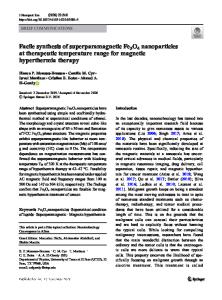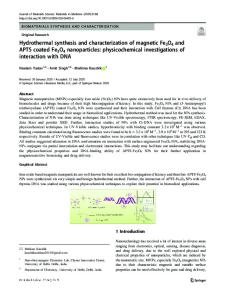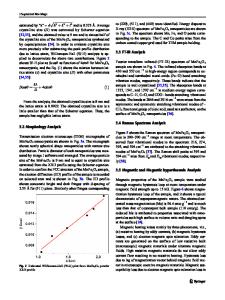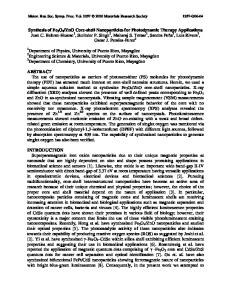Fe 2 O 3 nanoparticles for magnetic hyperthermia applications
- PDF / 341,470 Bytes
- 7 Pages / 432 x 648 pts Page_size
- 89 Downloads / 609 Views
Fe2O3 nanoparticles for magnetic hyperthermia applications O M Lemine1 , Karim Omri2 , L El Mir 1, 2, V Velasco3 , Patricia Crespo3,4, Patricia de la Presa3,4 , Hoicine Bouzid5 , Ali Youssif6 and Ali Hajry5 1 Physics Department, College of Sciences, Al Imam Mohammad Ibn Saud Islamic University (IMSIU), Riyadh, Saudi Arabia. 2 Laboratory of Physics of Materials and Nanomaterials Applied at Environment (LaPhyMNE), Faculty of Sciences in Gabes, Gabes, Tunisia. 3 Instituto de Magnetismo Aplicado, UCM-ADIF-CSIC, Spain 4 Dpto. Física de Materiales, Universidad Complutense de Madrid, Spain 5 Promising Centre for Sensors and Electronic Devices (PCSED), Najran University, P.O. Box 1988, Najran-11001, Saudi Arabia 6 Department of Physics, College of Science, Sultan Qaboos University, P.O. Box 36, Code 123, Al Khoud, Oman
ABSTRACT Synthesis, structural, magnetic properties and heating efficiency of γ-Fe2O3 nanoparticles have been investigated. X-ray diffraction (XRD) and Mössbauer spectroscopy show that the obtained nanoparticles are mainly composed of maghemite phase (γ-Fe2O3). Williamson-Hall method shows that the crystallite is around 14nm.The specific absorption rate (SAR) under an alternating magnetic field is investigated as a function of frequency. A highest SAR value of 12W/g for frequency 523 kHz was obtained. INTRODUCTION Iron oxide nanoparticles have attracted increasing attention due to their immense broad range of technological applications [1-4]. Among the magnetic nanoparticles, maghemite has attracted particular interest for several important biomedical applications such as drug delivery, magnetic hyperthermia and magnetic resonance imaging (MRI) [5-7].Magnetic hyperthermia is a cancer treatment method which uses the capability of magnetic nanoparticles to generate heat when exposed to alternating magnetic field (AMF) [8, 9], this heating capability is determined by the specific absortion rate (SAR) of the nanoparticles. Two different types of magnetic relaxation mechanisms are responsible for the heat generation: the relaxation of magnetic moments inside the volume (Neel relaxation) or the relaxation of magnetic moments fixed to the particles (Brownian relaxations)[9]. In this work, we present the synthesis; characterization and heating efficiency of γ-Fe2O3 nanopaticles synthesized by modified sol-gel method. Structural, morphological and magnetic properties of the obtained nanoparticles were studied by XRD, TEM, SQUID, and Mössbauer spectrometry. EXPERIMENTAL Iron oxide Fe2O3 nanoparticles sampleis prepared by modified a sol–gel method modified under supercritical conditions of ethyl alcohol (EtOH) [11]. X-ray powder diffraction (XRD)
7
measurements are performed by PANalyticalXpertPro diffractometer with Cu-k radiation (λ = 1.54178 Ǻ) in the range 2θ = 20 -70° at 0.02° step.The average crystallites size is calculated by the Williamson-Hall method. In the Williamson-Hall method, the analysis includes two steps: First step: the width ( ) of every peak was measured as the integral breadth. The instrumental
Data Loading...











